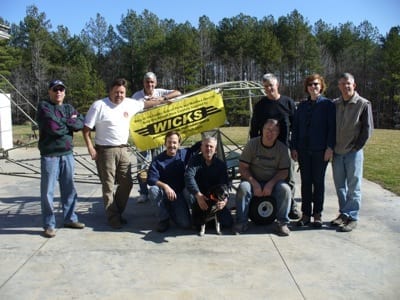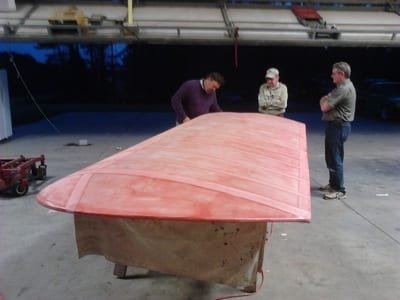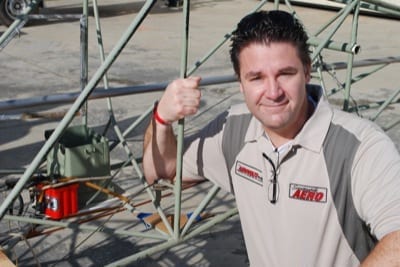Last September I reported on our efforts to complete a rare Stits SA-7D Skycoupe project first begun in the early 1960s. Our group of homebuilders in central North Carolina set a few basic goals to achieve by the end of the year: Form a club; recover all flying surfaces; and return the plane’s Lycoming O-290-D engine to operation.
Thanks to strong interest among area builders, we achieved our initial goals, and a few others we had not planned.

By Thanksgiving, we had incorporated the non-profit “Bear Creek Aero Club,” with the mission to teach homebuilding skills, complete unfinished projects, and restore forgotten “hangar queens,” and then fly them at rock-bottom prices. We now have nine full members and a dozen associate members. Members have access to our growing inventory of tools and a large workshop for projects owned both by the club and its members. A one-time $1,200 membership fee buys a full membership, which gives the person flying rights. These memberships will finance the completion of our current project.
By Thanksgiving we also finished all the prep work on the plane’s sturdy wooden wings and completed most of the Poly-Fiber covering up to the pink Poly-Brush coatings. Thanks to the excellent written and video training material from Poly-Fiber, we held several rib-stitching practice sessions, which allowed our club president and EAA Technical Counselor Terry Gardner to choose the best people to do the work on the Skycoupe’s wings. Since Thanksgiving, we have finished all rib stitching and, on days when the temperature exceeded 70°, applied most of the protective tapes, the last step before spraying on the silver coats.

Since composites were not in wide use back in the 1950s when Ray Stits designed the Skycoupe, we chose to use foam and fiberglass on parts of the wing’s root and tip where composites were ideal for the compound curvature found there. This provided an opportunity to teach another important branch of homebuilding skills, and the final results were excellent.
Preparations for our engine’s first run in nearly 20 years began with a thorough investigation of all components. A borescope of the cylinders showed these to be in good condition, with no corrosion or pitting. To our surprise, compression was excellent. The starter and magnetos were another story however — both needed major repair. The Delco starter was rebuilt for $85 by a local auto electric shop that specializes in classic cars; it runs like a top now!

When we learned that the Bendix Scintilla magnetos were ancient and repairs would be costly, we started hunting for a replacement. Fortunately, Gardner’s A&P just happened to have a set of near-new mags that she sold to us at a deep discount. When it came time to look for a battery to crank our engine, one of our members, Steve Johnson, donated a lightweight AeroVoltz lithium-ion battery that he sells through his company, Everything Aero. The actual engine start-up was anti-climactic — it fired up within a few rotations of the prop and sounds great.
What’s next? Realizing that we need to “divide and conquer” to have the airplane flying in 2012, we developed a list of 25 separate groups, for instance, engine, exhaust, seating, controls, etc. Each member has been assigned one or more groups to research and then propose the best options, which includes the design, materials and components needed, cost and weight. Who does the work depends on member skills and experience, with the final decision to be made by the club’s officers in consultation with the most experienced homebuilders and A&Ps in our area.

Much attention has focused on the panel — a contrast of old and new technology — with the primary instruments an iFly 700 GPS/moving map and MGL flight and engine displays.
Several great things are evolving from the Bear Creek Aero Club: Many of our members are realizing a lifelong dream of building an airplane. We are learning, and teaching, a variety of building skills at a rapid pace, including wood-working, composites, fabric covering, engines, avionics, electrical systems, welding and sheet metal fabrication. Word has spread, resulting — to our great surprise — in many donations from suppliers and even two homebuilders who gave us an unfinished BD-4 project and a set of quick-build RV-7 wings. The BD-4 has since been sold to a builder in Memphis, and we’re now finishing the RV-7 wings and will sell these to raise additional cash for the Skycoupe and future projects. The sheet metal skills we’ve gained working on these wings have helped other builders of RV-6, RV-9, RV-10 and RV-12 projects in our area, especially the dreaded assembly of RV fuel tanks (below).
 As president of EAA 1114, one of the largest and most active chapters in the country, I have enjoyed watching how our Bear Creek Aero Club has reinvigorated some of our members whose projects have been gathering dust for years. As one of our members put it, “With the skills I have learned, I am not afraid to take on any project now.”
As president of EAA 1114, one of the largest and most active chapters in the country, I have enjoyed watching how our Bear Creek Aero Club has reinvigorated some of our members whose projects have been gathering dust for years. As one of our members put it, “With the skills I have learned, I am not afraid to take on any project now.”
We have been fortunate to have the world’s most knowledgeable Skycoupe expert as our advisor — the airplane’s designer, Ray Stits. He calls me regularly from his home in Riverside, Calif., to comment on our progress and make suggestions. His many anecdotes from the early days of homebuilding are priceless and I feel fortunate to be the recipient of his wisdom. Generous support of our efforts has come from the following companies: Poly Fiber (Consolidated Aircraft Coverings), Bipe Inc. Antique Aircraft Restoration Services, Wicks Aircraft Supply, Everything Aero, Marvel-Schebler Aircraft Carburetors, GeoBeck, Vetterman Exhaust, and Aero Accessories.
Follow the club’s progress at EAA1114.Blogspot.com
People who read this article also read articles on airparks, airshow, airshows, avgas, aviation fuel, aviation news, aircraft owner, avionics, buy a plane, FAA, fly-in, flying, general aviation, learn to fly, pilots, Light-Sport Aircraft, LSA, and Sport Pilot.
